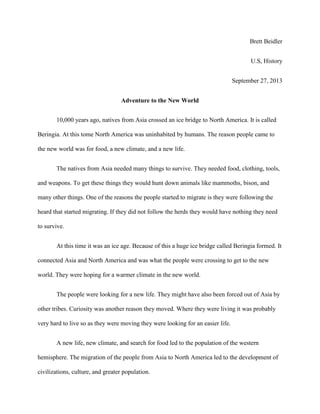5 paragrph essay
•Download as DOCX, PDF•
1 like•216 views
The natives from Asia crossed an ice bridge called Beringia around 10,000 years ago to migrate to uninhabited North America. They made the journey in search of food, a new climate, and a new life, as changing conditions in Asia made surviving there difficult. The ice age had formed the land bridge between the continents, allowing people to follow animal herds for resources. Their migration led to the initial population of the western hemisphere and establishment of civilizations and culture.
Report
Share
Report
Share

Recommended
Recommended
Final Power Point Presentation Chapter 10 Ojibwa

Anthropology 101
Professor: Jo Ann Worthington
Final Power Point Presentation Chapter 10
The Ojibwa: "The People Endure"
Native american tribes

This is an information presentation about the native American Tribes including what the different main parts' are
Native Americans Powerpoint

This is a good and reliable powerpoint about native americans. You should probably look at it.
More Related Content
What's hot
Final Power Point Presentation Chapter 10 Ojibwa

Anthropology 101
Professor: Jo Ann Worthington
Final Power Point Presentation Chapter 10
The Ojibwa: "The People Endure"
Native american tribes

This is an information presentation about the native American Tribes including what the different main parts' are
Native Americans Powerpoint

This is a good and reliable powerpoint about native americans. You should probably look at it.
What's hot (20)
Viewers also liked
Viewers also liked (8)
Similar to 5 paragrph essay
2 - First Americans - Presentation.pptx

Powerpoint describing the first inhabitants of North America.
Early American Civilizations (Pre-Columbian)

This slide is a brief overview of civilizations extant in North, South, and Mesoamerica in Pre-Columbian times.
Similar to 5 paragrph essay (20)
Early humans and the agricultural revolution powerpt

Early humans and the agricultural revolution powerpt
5 paragrph essay
- 1. Brett Beidler U.S, History September 27, 2013 Adventure to the New World 10,000 years ago, natives from Asia crossed an ice bridge to North America. It is called Beringia. At this tome North America was uninhabited by humans. The reason people came to the new world was for food, a new climate, and a new life. The natives from Asia needed many things to survive. They needed food, clothing, tools, and weapons. To get these things they would hunt down animals like mammoths, bison, and many other things. One of the reasons the people started to migrate is they were following the heard that started migrating. If they did not follow the herds they would have nothing they need to survive. At this time it was an ice age. Because of this a huge ice bridge called Beringia formed. It connected Asia and North America and was what the people were crossing to get to the new world. They were hoping for a warmer climate in the new world. The people were looking for a new life. They might have also been forced out of Asia by other tribes. Curiosity was another reason they moved. Where they were living it was probably very hard to live so as they were moving they were looking for an easier life. A new life, new climate, and search for food led to the population of the western hemisphere. The migration of the people from Asia to North America led to the development of civilizations, culture, and greater population.